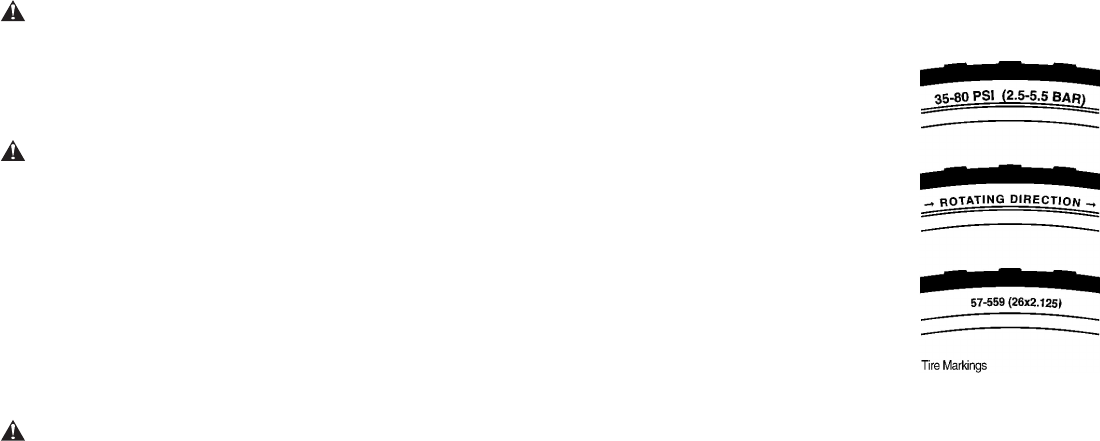
WARNING: Never inflate a tire beyond the maximum pressure marked on the tire’s sidewall. Exceeding the recommended maximum
pressure may blow the tire off the rim, which could cause damage to the bike and injury to the rider and bystanders.
The best and safest way to inflate a bicycle tire to the correct pressure is with a bicycle pump which has a built-in
pressure gauge.
WARNING: There is a safety risk in using gas station air hoses or other air compressors. They are not made
for bicycle tires. They move a large volume of air very rapidly, and will raise the pressure in your tire very rapidly,
which could cause the tube to explode.
Tire pressure is given either as maximum pressure or as a pressure range. How a tire performs under different terrain
or weather conditions depends largely on tire pressure. Inflating the tire to near its maximum recommended pressure
gives the lowest rolling resistance; but also produces the harshest ride. High pressures work best on smooth, dry
pavement.
Very low pressures, at the bottom of the recommended pressure range, give the best performance on smooth, slick
terrain such as hard-packed clay, and on deep, loose surfaces such as deep, dry sand.
Tire pressure that is too low for your weight and the riding conditions can cause a puncture of the tube by allowing the
tire to deform sufficiently to pinch the inner tube between the rim and the riding surface.
CAUTION: Pencil type automotive tire gauges can be inaccurate and should not be relied upon for consistent, accurate pressure
readings. Instead, use a high quality dial gauge.
Ask your dealer to recommend the best tire pressure for the kind of riding you will most often do, and have the dealer inflate your tires to that
pressure. Then, check inflation as described in Section 1.C so you’ll know how correctly inflated tires should look and feel. Some tires may need
to be brought up to pressure every week or two.
Some special high-performance tires have unidirectional treads: their tread pattern is designed to work better in one direction than in the other.
The sidewall marking of a unidirectional tire will have an arrow showing the correct rotation direction. If your bike has unidirectional tires, be
sure that they are mounted to rotate in the correct direction.
2. Tire Valves
There are primarily two kinds of bicycle tube valves: The Schraeder Valve and the Presta Valve. The bicycle pump you use must have the fitting
appropriate to the valve stems on your bicycle.
The Schraeder valve (fig. R) is like the valve on a car tire. To inflate a Schraeder valve tube, remove the valve cap and clamp the pump fitting
fig. Q
31


















